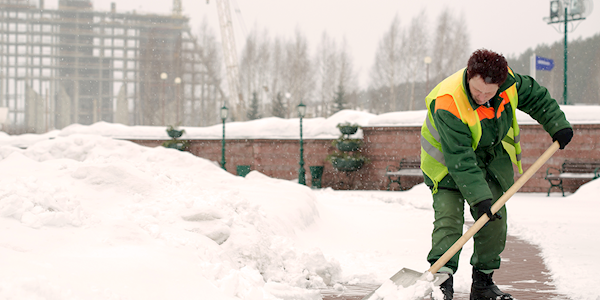
‘Assessing the risks’ and ‘acting reasonably’ can be open to interpretation when it comes to snow and ice. For example, it is probably unreasonable to expect a business to clear entire areas of snow outside their building when staff and visitors will only be using clearly-defined paths and car parking areas.
But, how far do you decide to go? And what if someone still slips in an area that has been cleared or gritted? Can they make an injury claim? If so, could your business defend itself?
- The Health and Safety at Work Act 1974 requires employers to ensure the health and safety of all employees and anyone affected by their work, so far as is reasonably practicable.i
- The Management of Health and Safety at Work Regulations 1999 require employers to assess risks and, where necessary, take action to address them.
- The Workplace (Health, Safety and Welfare) Regulations 1992 require floors to be suitable, in good condition and free from obstructions.
All of these regulations include managing slip and trip risks.
Snow clearance and your liability
If you have followed the relevant guidance to clear a path of snow or ice to prevent residual risks, but someone still slips on that path, it is unlikely that your organisation will be held responsible for an injury to an employee or member of the public. Paperwork and risk assessments are critical to confirm the action you have taken. This can significantly improve your chances of defending a claim, should one arise.
Not clearing the snow and ice at all should not be a consideration when there is clear guidance available—neither can the cost of de-icing be a reasonable defence.
You should consider the person performing the task. If this is the responsibility of someone within an organisation, you must provide them with adequate training, equipment and protective clothing. This can help protect the organisation in the event of an employee liability claim.
Guidance on snow clearance and gritting
- When clearing snow and ice, clear the middle of the path first so there is a safe surface on which to walk.
- Ensure you are not clearing it onto other pavement areas or onto a road (as well as potentially creating other safety issues, it is also an offence).
- The earlier you grit surfaces, the better, before the snow has a chance to freeze. The best times to use grit are early in the evening before the frost settles and/or early in the morning before employees arrive. Check the weather forecast so you can plan ahead.
- Rock salt (plain and treated) is the most commonly used grit and is the substance used on public roads by the highways authority. If you do not have access to grit, sand or ash can be used as an alternative.
- Do not pour water to dissolve the snow and ice as the temperature may still be low enough for the water to freeze and create black ice, compounding the problem.
- Use warning signs if possible. Grit will take longer to be ground down (to be more effective) on pedestrian areas than on roads, so clear signage may help to protect the business in the event of a personal injury claim for a slip or fall.
- If you need to be sparing with grit, consider gritting the most heavily-used pathways and blocking off others with barriers or signs. Pay particular attention to any pedestrian short-cuts used—either grit them or block them off.
- If you do use warning signs or cones, remember to remove them once the hazard has passed so they will not be ignored the next time they are necessary.
- Avoid gritting when it is raining heavily or the salt will be washed away, causing issues if the rain then turns to snow, as the snow can become impacted and turn to ice.
- Inside the building, ensure there is adequate ‘wet floor’ signage at the entrance, and plans in place to regularly mop/dry potentially hazardous areas.
Further health and safety considerations
The winter months can also increase other risks for your business, with freezing temperatures and the potential for flood/storm damage. It is important, therefore, to keep on top of your building maintenance, from checking roof tiles, drainage channels, trees near buildings, and insulation—particularly ensuring pipes are lagged to prevent them from freezing.
The increased use of heating equipment during the winter can heighten the risk of accidental fires, particularly where has been poor maintenance of electrical equipment, sockets are overloaded or equipment is not being used properly. If your fire risk assessment has not been reviewed lately, you should make this a priority.
Lastly, when your employees are out on the roads, it’s essential to adhere to safety guidelines for driving in wintery conditions, such as fog, snow and ice, and also in heavy rain or high winds. See our guidance on managing winter driving risk for a recap.
Partner with a risk management specialist
Gallagher can support you in all areas of risk management, including helping you meet your health and safety obligations, now and throughout the year. Our Risk and Regulations Management Toolkit is particularly useful for small and medium-sized businesses that want to keep on top of their risk management, and involve and educate their employees.
Taking a proactive approach to managing and mitigating risk can not only help to protect your business, but it may also lead to fewer claims and lower insurance premiums in the future.


